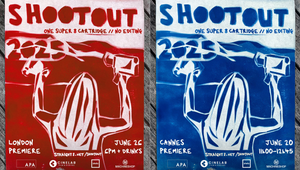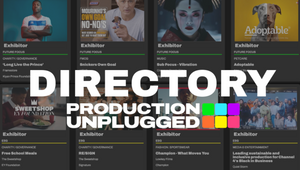
The Industry’s Best Advice to Young Producers

Yesterday, January 31st, the London Transport Museum held APA’s seminar conversation focusing on the ins and outs of commercial production. Putting together experts in the fields of production, sound design, VFX, and talent scouting, the two-hour talk gave way for these coming two weeks of nurturing young talent. Preceding next week’s masterclass for aspiring producers held by the APA, this talk gave a comprehensive overview of the industry for anybody taking their first steps into it, or to those who are not yet sure which part of it they want to occupy. Here’s their best advice.
Production’s Multitudes of Positions
The talk began with RiffRaff’s executive producer Matthew Clyde and Odelay Films managing director Prudence Beecroft, taking the stage with a slow and steady guide into production as a whole. After covering the workflows within commercial production, and explaining that projects may come either directly from brands or from ad agencies, the two went through a list of jobs within production that not all of us might be aware of.
And although an interesting fact remained to be that animal tamers actually possess quite the lucrative position, they covered a number of other roles that aspiring producers and directors might be blissfully unaware of. A grip, for example, Matthew said, is somebody who takes care of positioning the camera in such a way, that the artistry behind the shot is not lost regardless of how difficult this might prove to be. Or, added Prudence, a ‘gaffer’, which turns out to be just another word for head of the lighting department.
So, as it turns out, regardless of if you’re interested in animal taming or good old producing, there will be space for you.
In terms of getting your foot in the door of production, both Matthew and Prudence agreed that two of the most important things are to remember to keep your relationships thriving and accept that being a runner is the best way in.
This was, in fact, a running theme throughout the event, with which essentially everybody agreed - not only do runners get remembered by those who they work with, said the experts, but they are also more likely to see every side of the production process without actually participating, which, according to Matthew, is an extremely unique view.
Keep It Short and Visual, and Nurture Relationships
Next, Charlie Roberson, head of talent and new business at Rogue Films, and Farai Mbudaya, director’s representative at Darling Films took the stage with their two cents. As what Charlie called ‘the sales people’ of the production industry, the two of them presented their role as a complicated, but quite tempting position for aspiring talent.
“It’s a job that requires a lot of self motivation,” said Farai. “We are essentially talent agents, we are the pre-pre-production process.” And, as such, they both agreed that as part of talent management, one needs to be extremely communicative and constantly aware of what everybody is doing.
We’re not just talking about their own clients and colleagues, but having a holistic awareness of industry-wide trends and emerging names is paramount to the position of a talent manager. Keeping up with media outlets in the industry, they both agreed, does not only help with that but also can give you an idea of who is important to befriend and who is out there actively helping young talent.
But, you might wonder, what would be the best advice for a director’s representative or talent scouts to those who want to get noticed on their own? “You need to leave something visual to work with,” said Charlie. “But the work, even if it isn’t commercial, has to resonate with the industry and look like something workable for a brand.” He added, “Keep it short and sweet, always have visuals, and always make sure to have an outbound link in there.”
Farai added that whilst young talent might be trying to get noticed and doing outreach, they shouldn’t shy away from runner’s jobs and copywrite on the side. This also helps with their other advice, which was to nurture relationships from early on. “The relationships are going to be the most important thing you have in this industry, down the line they will be deciding,” said Charlie. Although saying that it might not be a pretty process, when getting into the industry, Farai was certain that those who truly want it, occupy a space within it through that power. “You know why you’re here, and that’s where your power is,” he said. And, with the right treatment or two, things can start to happen.
Engage with Mentors and Don’t Shy Away from Being a Runner
Mary-Ann D’Cruz, new business and marketing director at No.8 and Abi Klimaszewska, the head of production at Unit came on next to talk about post and audio, two notoriously confusing parts of production for those that are not yet in it. Abi explained that though there are many roles included in the post-production process, they all work simultaneously. From the start where the offline process takes place, to the very end, however, post-production people or those that want to be in their shoes need to understand that communication is vital in this position.
“You need to make everyone happy,” said Abi. And although agency and brand, or agency and production might have severed ties by the end, you still need to come up with a product that makes everybody happy - which is difficult, but extremely rewarding. She then went on to break down the roles that people might occupy in CG, 3D, VFX, motion graphics and grading, all of which are niches that are part of post. The one thing worth mentioning here is that out of these, colour grading is probably the hardest one to get into. Abi advised those who have a passion for it to nurture that from early on and find a mentor to stick by and understand that colour graders are the ones working closest to the DOP.
Mary-Ann then took the stage, from the perspective of sound, and echoed previous opinions - although sound can also be difficult to get into, the biggest advice she gave is never to turn away from a runner’s job, as it is the most common way to get into sound. And although currently, the gender divide in that part of the industry shows a bigger proportion of men, that is changing, and we are perhaps seeing the first generation of women overtaking men in the sound departments all over the world.













